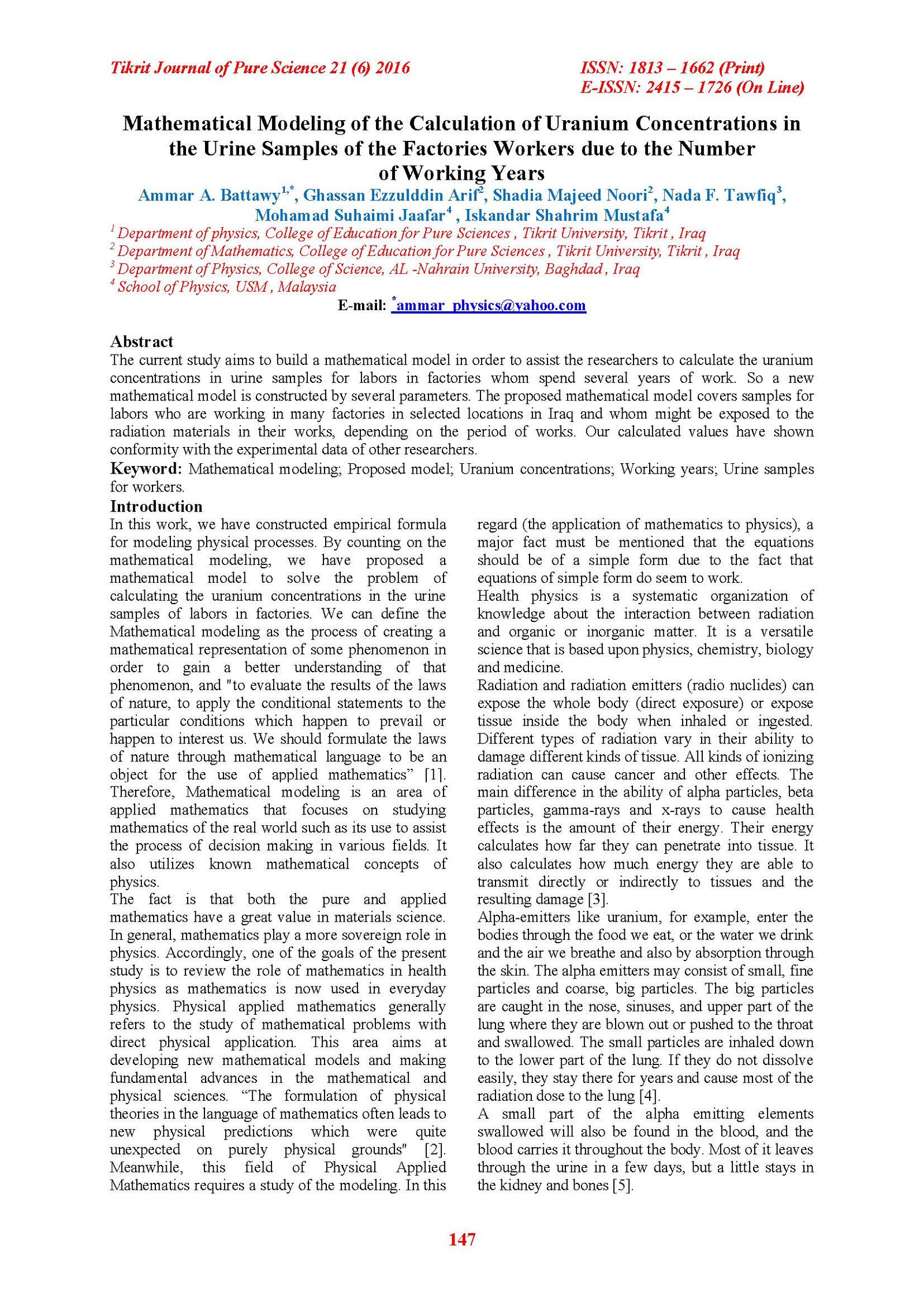Mathematical Modeling of the Calculation of Uranium Concentrations in the Urine Samples of the Factories Workers due to the Number of Working Years
Main Article Content
Abstract
The current study aims to build a mathematical model in order to assist the researchers to calculate the uranium concentrations in urine samples for labors in factories whom spend several years of work. So a new mathematical model is constructed by several parameters. The proposed mathematical model covers samples for labors who are working in many factories in selected locations in Iraq and whom might be exposed to the radiation materials in their works, depending on the period of works. Our calculated values have shown conformity with the experimental data of other researchers.
Article Details

This work is licensed under a Creative Commons Attribution 4.0 International License.
Tikrit Journal of Pure Science is licensed under the Creative Commons Attribution 4.0 International License, which allows users to copy, create extracts, abstracts, and new works from the article, alter and revise the article, and make commercial use of the article (including reuse and/or resale of the article by commercial entities), provided the user gives appropriate credit (with a link to the formal publication through the relevant DOI), provides a link to the license, indicates if changes were made, and the licensor is not represented as endorsing the use made of the work. The authors hold the copyright for their published work on the Tikrit J. Pure Sci. website, while Tikrit J. Pure Sci. is responsible for appreciate citation of their work, which is released under CC-BY-4.0, enabling the unrestricted use, distribution, and reproduction of an article in any medium, provided that the original work is properly cited.
References
[1] Wigner, E.P., The unreasonable effectiveness of mathematics in the natural sciences. Richard courant lecture in mathematical sciences delivered at New York University, May 11, 1959, Communications on pure and applied mathematics, 13, 1-14, (1960).
[2] Blaha, P., Schwarz, K., Madsen, G., Kvasnicka, D. and Luitz, J. WIEN2k, An augmented plane wave plus local orbitals program for calculating crystal properties, Vienna University of Technology, Austria, (2001).
[3] Camber, H., Introduction to Health Physics, second ed., Pergamon Press, New York, (1987).
[4] Source and Effects of Ionizing Radiation, UNSCEAR, (New York, United Nation, pp. 33-91, (1993).
[5] Hassan S. F., Determination of uranium concentration in human blood in some Governorates of Iraq, MSc Thesis, College of Science, Al-Nahrain University, Iraq, (2006).
[6] Marouf, B.A., Environmental Impact of Depleted Uranium (DU) Contamination in Iraq, The Conference on The Effects of The Use of Depleted Uranium Weaponry on Human and Environmental in Iraq, Baghdad-Iraq, 1, 116-122, (2002).
[7] Fleischer, R.L., Price, P.B. and Walker, R.M., Nuclear Tracks in Solid, California Univ. Press, Berkeley, (1975).
[8] Arif, G. E., Abdullah, F. A. and Al-Douri, Y. Modeling of the Electronic Properties of Hexagonal Semiconductors. Advanced Materials Research Vol. 925, pp. 364-368. (2014).
[9] Abu-Farsakh, H. and Qteish, A. Ionicity scale based on the centers of maximally localized Wannier functions. Physical Review B, 75(8), 085201-085206. (2007).
[10] Abdullah, A. A. Internal and External Radiation Exposure Evaluation Amongst Selected Workers and Locations in Iraq, PhD. Theses, School of Physics, USM, Malaysia, (2013).
